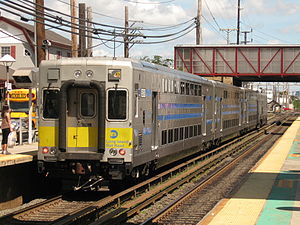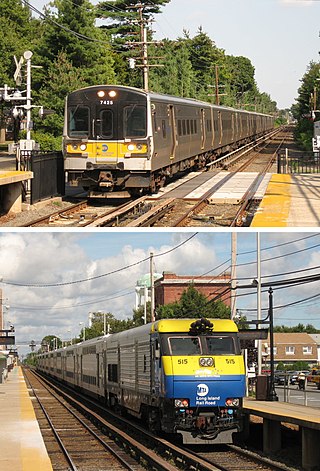
The Long Island Rail Road, or LIRR, is a railroad in the southeastern part of the U.S. state of New York, stretching from Manhattan to the eastern tip of Suffolk County on Long Island. The railroad currently operates a public commuter rail service, with its freight operations contracted to the New York and Atlantic Railway. With an average weekday ridership of 354,800 passengers in 2016, it is the busiest commuter railroad in North America. It is also one of the world's few commuter systems that runs 24/7 year-round. It is publicly owned by the Metropolitan Transportation Authority, which refers to it as MTA Long Island Rail Road. In 2023, the system had a ridership of 75,186,900, or about 276,800 per weekday as of the second quarter of 2024.

A bilevel car or double-decker coach is a type of rail car that has two levels of passenger accommodation as opposed to one, increasing passenger capacity.

The Port Jefferson Branch is a rail line and service owned and operated by the Long Island Rail Road in the U.S. state of New York. The branch splits from the Main Line just east of Hicksville and runs northeast and east to Port Jefferson. Several stations on the Main Line west of Hicksville are served primarily by trains bound to/from the Port Jefferson branch, so LIRR maps and schedules for the public include that part of the Main Line in the "Port Jefferson Branch" service.

The Kawasaki Railcar Manufacturing Company is the Japanese rolling stock manufacturing subsidiary of Kawasaki Heavy Industries. Since beginning operations in 1906, the company has produced more than 90,000 railroad cars.
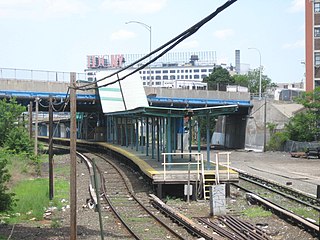
The Hunterspoint Avenue station is a station on the Main Line of the Long Island Rail Road within the City Terminal Zone. It is located at 49th Avenue between 21st Street and Skillman Avenue in the Hunters Point and Long Island City neighborhoods of Queens, New York City. This ground-level station has an island platform between two tracks and is currently not wheelchair accessible from the entrance above the station.
The Long Island Rail Road owns an electric fleet of 202 M9, 836 M7, and 170 M3 electric multiple unit cars, and a diesel and diesel-electric fleet consisting of 134 C3 bilevel rail cars powered by 24 DE30AC diesel-electric locomotives and 20 DM30AC dual-mode locomotives.

The M8 is an electric multiple unit railroad car built by Kawasaki for use on the Metro-North Railroad New Haven Line and the CT Rail Shore Line East. The fleet of 471 cars first entered service in 2011, replacing the M2, M4 and M6 cars, which entered service in 1973, 1987 and 1994, respectively. An additional 60-car order is currently finishing delivery in response to increased ridership and usage on Shore Line East.

The Penn Line is a MARC passenger rail service operating between Union Station in Washington, D.C., and Perryville, Maryland, along the far southern leg of the Northeast Corridor; most trains terminate at Baltimore's Penn Station. It is MARC's only electrified line, though a majority of trains remain diesel powered. With trains operating at speeds of up to 125 miles per hour (201 km/h), it is the fastest commuter rail line in the United States. The service is operated by Amtrak under contract to the Maryland Transit Administration. MARC sets the schedules, owns most of the stations, and controls fares, while Amtrak owns and maintains the right-of-way, supplies employees to operate trains, and maintains the rolling stock. It is the busiest of MARC's three lines, with twice as many trains and riders as the Brunswick and Camden lines combined.

Greenvale is a station on the Long Island Rail Road's Oyster Bay Branch. The station is located off Helen Street, between Glen Cove Avenue and Glen Cove Road in the Incorporated Village of Roslyn Harbor, in Nassau County, New York.

The M9 is a class of electric multiple unit railroad cars being built by Kawasaki Heavy Industries for use on the MTA's Long Island Rail Road (LIRR) and Metro-North Railroad. They entered service September 11, 2019. These cars will replace the M3/M3A railcars built during the early 1980s, as well as expand the LIRR fleet to provide additional service after the completion of the LIRR's East Side Access project. A separate order of cars purchased for the LIRR and Metro-North using federal funding for the East Side Access project will also be designated M9A.
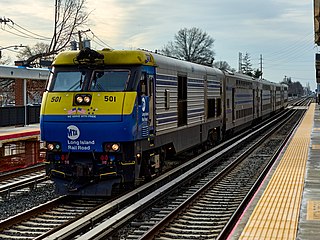
The EMD DE30AC and DM30AC are a class of 46 locomotives built between 1997–1999 by Electro-Motive Division in the Super Steel Plant in Schenectady, New York, for the Long Island Rail Road of the Metropolitan Transportation Authority (MTA) in New York. Originally divided equally between the two types, the fleet currently consists of 24 DE30AC locomotives and 20 DM30AC locomotives.

The MultiLevel Coach is a bi-level passenger rail car for use on commuter rail lines. Originally built by Bombardier Transportation beginning in 2006, they are now built by Alstom since 2021, who markets the coaches as part of their Adessia Coach series.

The M7 is an electric multiple unit railroad car built by Bombardier for use on the MTA's Long Island Rail Road (LIRR) and Metro-North Railroad. With delivery beginning in 2002, the M7 replaced the M1 railcars on both railroads as well as the ACMUs on Metro-North. The cars built for Metro-North were designated as the M7As, and contain minor differences from the M7s found on the LIRR. A total of 1,172 M7 cars were built for the two railroads.
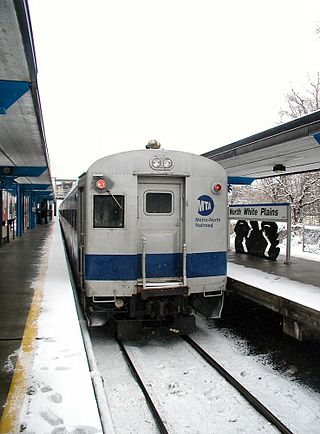
The ACMUs were a series of electric multiple unit railcars built for the New York Central Railroad in three orders between 1950 and 1965. The ACMUs were intended to replace/supplement the original fleet of heavyweight MU cars, some of which dated to the start of electric operations on the New York Central. These were the first New York Central units to offer air conditioning, with sealed windows replacing the drop sash and clerestory types found on earlier cars. The initial set of 100 cars was retired in 1970, upon completion of the M1 railcar delivery, while the second and third orders, totaling 87 cars, remained in service until 2004, when they were replaced by the new M7 fleet.
The Metro-North Railroad is a commuter railroad serving northern suburbs of New York City. It principally uses a fleet of electric railcars for its services; diesel locomotives and push-pull coaches are in use as well for non-electrified portions of the system.

The PRR MP70, also known informally as the "double-deckers", was a class of electric multiple units manufactured by the Pennsylvania Railroad for use on the Long Island Rail Road (LIRR). The Pennsylvania Railroad manufactured three prototypes in the 1930s and a full fleet of sixty cars in 1947–1949. They were among the first examples of bilevel rail cars in the United States. The design was unpopular with both LIRR employees and commuters; the last cars were retired in 1972. A single example, the prototype, is preserved at the Railroad Museum of Long Island.

The C1 is a type of bilevel commuter passenger car built by the Tokyu Car Corporation for the Long Island Rail Road (LIRR). Tokyu built ten cars in 1990–1991 as a precursor to the larger C3 order, which would be built by Kawasaki in the late 1990s. The cars were designed by Comeng, one of the last projects that the firm undertook before closing in 1990. After the arrival of the C3s, the Long Island Rail Road sold the C1s to private owners.

The Cannonball is a seasonal named train operated by the Long Island Rail Road between Penn Station in New York City and Montauk on the east end of Long Island, New York. The train operates weekly between Memorial Day and Labor Day weekend, operating eastbound on Fridays and westbound on Sundays, with westbound service also being offered through Columbus Day weekend. The train utilizes dual-mode DM30AC locomotives and C3 coaches, the same rolling stock as other LIRR diesel and dual-mode trains, and takes slightly less than three hours to travel the 118-mile (190 km) route.

The Montauk Cutoff is an abandoned railway in Long Island City, Queens, New York City, that connected the Long Island Rail Road's Main Line and Lower Montauk Branch.
